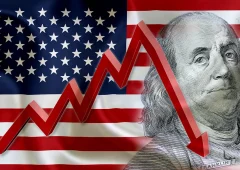U.S. Report on Inflation is Out – Here is What You Should Know
30.08.2024 15:30 1 min. read Alexander Stefanov
The PCE inflation report released moments ago will likely to reinforce expectations of an impending Federal Reserve interest rate cut.
For July, the core PCE Price Index increased by 0.2% month-over-month (MoM), maintaining the same growth rate as June. Annually, core PCE has risen by 2.6%, lower than expectations.
The core PCE Price Index, which omits the more volatile food and energy prices, plays a crucial role in shaping market expectations regarding the Fed’s interest rate decisions.
As it excludes erratic components, this indicator is closely watched by both the central bank and market participants to gain a clearer perspective on underlying inflation trends.
Earlier this month, data from the Bureau of Labor Statistics (BLS) revealed that the U.S. Consumer Price Index (CPI) increased by 2.9% annually in July, while the core CPI rose by 3.2%, slightly lower than the 3.3% recorded in June.
The Fed’s preferred inflation gauge for July shows a sustainable trend of disinflation, bolstering Federal Reserve officials’ confidence as they eye interest rate cuts next month.
-
1
Billionaire Slams Meme Stock Hype and Sounds Alarm on U.S. Fiscal Health
15.06.2025 18:00 2 min. read -
2
Robert Kiyosaki Predicts 2025 “Super-Crash,” Urges Hoarding Gold, Silver, and Bitcoin
23.06.2025 13:31 2 min. read -
3
Nassim Taleb Says Global Trust Is Shifting from the Dollar to Gold
22.06.2025 17:00 1 min. read -
4
Billionaire Investor Sees Dollar Crash If Key Support Breaks
18.06.2025 15:00 1 min. read -
5
Geopolitical Shockwaves Hit Ethereum Hard While Bitcoin Stays Resilient
22.06.2025 16:21 1 min. read
Robert Kiyosaki Predicts When The Price of Silver Will Explode
Robert Kiyosaki, author of Rich Dad Poor Dad, has issued a bold prediction on silver, calling it the “best asymmetric buy” currently available.
U.S. PCE Inflation Rises for First Time Since February, Fed Rate Cut Likely Delayed
Fresh data on Personal Consumption Expenditures (PCE) — the Federal Reserve’s preferred inflation gauge — shows inflation ticked higher in May, potentially delaying the long-awaited Fed rate cut into September or later.
Trump Targets Powell as Fed Holds Rates: Who Could Replace Him?
Federal Reserve Chair Jerome Powell is once again under fire, this time facing renewed criticism from Donald Trump over the Fed’s decision to hold interest rates steady in June.
U.S. National Debt Surge Could Trigger a Major Crisis, Says Ray Dalio
Billionaire investor Ray Dalio has sounded the alarm over America’s soaring national debt, warning of a looming economic crisis if no action is taken.
-
1
Billionaire Slams Meme Stock Hype and Sounds Alarm on U.S. Fiscal Health
15.06.2025 18:00 2 min. read -
2
Robert Kiyosaki Predicts 2025 “Super-Crash,” Urges Hoarding Gold, Silver, and Bitcoin
23.06.2025 13:31 2 min. read -
3
Nassim Taleb Says Global Trust Is Shifting from the Dollar to Gold
22.06.2025 17:00 1 min. read -
4
Billionaire Investor Sees Dollar Crash If Key Support Breaks
18.06.2025 15:00 1 min. read -
5
Geopolitical Shockwaves Hit Ethereum Hard While Bitcoin Stays Resilient
22.06.2025 16:21 1 min. read


